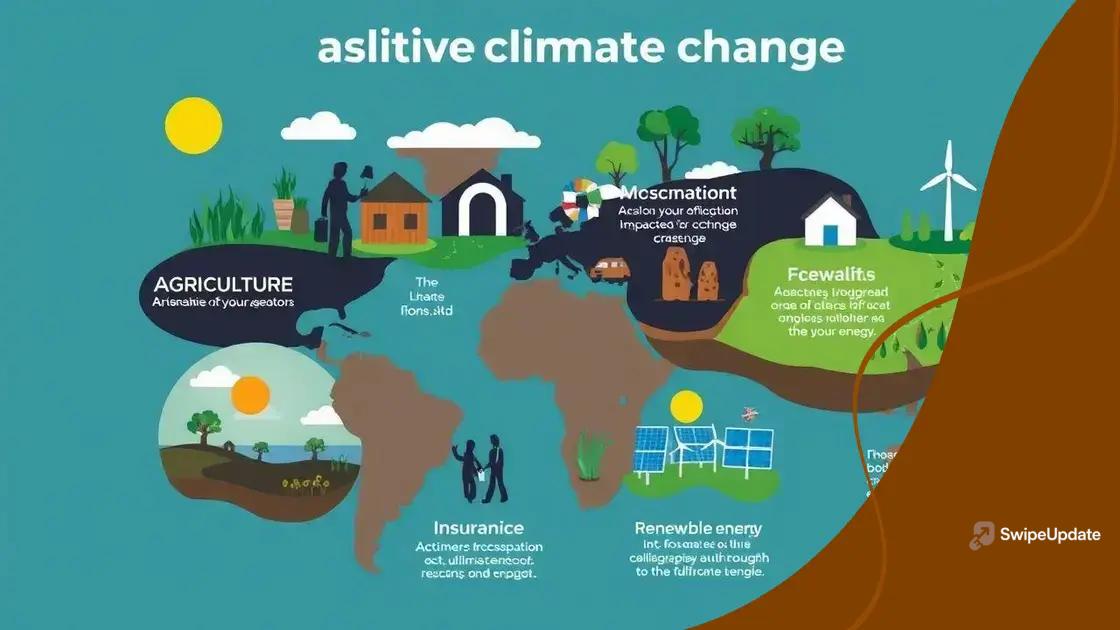Impact of climate change on investments: what you should know

The impact of climate change on investments reshapes financial strategies, emphasizing sustainability through ESG criteria, renewable energy, and technological innovation to mitigate risks and enhance portfolio resilience.
The impact of climate change on investments is shifting the landscape of financial decision-making. How are investors adapting to this growing concern? Let’s dive into this pressing topic to uncover insights.
Understanding climate change and its effects
Understanding climate change and its effects is crucial in today’s world. It influences not just our environment but also our financial systems. As temperatures rise, investors must be aware of the implications for their portfolios.
What is Climate Change?
Climate change refers to significant changes in global temperatures and weather patterns over time. While climate change is a natural phenomenon, human activities have accelerated its impact. This includes factors such as greenhouse gas emissions from burning fossil fuels.
Effects of Climate Change
As the climate shifts, various impacts become evident:
- Increased frequency of extreme weather events.
- Shifts in agricultural productivity.
- Rising sea levels threatening coastal investments.
- Higher insurance costs due to increased risk.
These changes create uncertainties for investors. Portfolio diversification becomes essential as some sectors may benefit while others may suffer.
Broader Economic Impacts
The economic implications of climate change extend to multiple sectors. For example, renewable energy industries are booming as governments push for sustainability. As a result, investors might find opportunities in green technology, which can lead to substantial returns.
On the other hand, traditional sectors, like oil and gas, may face declining investments. Understanding these trends will help investors navigate the climate change landscape effectively.
Investors must keep adapting to these changes. Continuous research and staying informed about climate-related policies will be crucial. By anticipating how climate change affects different investments, individuals can make smarter financial decisions.
How climate change influences investment strategies
How climate change influences investment strategies is becoming increasingly important for investors today. Understanding these shifts can help protect and grow portfolios.
Adaptation of Investment Strategies
To address the challenges posed by climate change, many investors are adapting their strategies. They are now considering environmental factors when evaluating potential investments. This involves assessing how companies respond to sustainability challenges, which can impact their long-term viability.
Green Investing Trends
Green investing has gained traction as a response to climate concerns. Many investors are putting money into companies that focus on renewable energy, sustainable practices, and efficient resource management.
- Investments in solar and wind energy have surged.
- Companies with strong sustainability practices often attract investors.
- ESG (Environmental, Social, and Governance) criteria are being integrated into investment decisions.
- Focusing on sustainable supply chains helps mitigate risks.
These shifts indicate a growing recognition of the risks associated with neglecting climate-related impacts. As a result, investors are becoming more conscientious about where they place their capital.
Risk Assessment in Investment Decisions
Also, climate change is reshaping how risk is assessed in investment decisions. Investors are evaluating exposure to climate-related risks, such as severe weather events and regulatory changes.
This risk evaluation helps in forecasting potential losses and identifying opportunities in emerging markets. For example, regions threatened by natural disasters may require increased infrastructure investment, presenting opportunities for growth.
Investors must continuously learn about climate change impacts to adjust their strategies effectively. The combination of managing risks and tapping into opportunities can lead to more resilient investment portfolios.
Sector-specific impacts of climate change

Sector-specific impacts of climate change are crucial to understanding how various industries will adapt and evolve. Each sector faces unique challenges and opportunities resulting from the ongoing environmental shifts.
Agriculture
Agriculture is one of the most affected sectors. Changes in weather patterns can result in unpredictable harvests. Farmers are now facing issues like:
- Increased droughts affecting crop yield.
- Shifts in pest populations disrupting production.
- Rising temperatures leading to reduced water supplies.
- More frequent storms damaging farmland.
These factors can significantly influence food prices and availability, which ultimately affect global markets.
Insurance
The insurance industry is also undergoing major transformations due to climate change. Companies are reevaluating their risk assessments. They are now considering:
- Higher premiums for areas with increased natural disasters.
- Excluding coverage for high-risk climates.
- Developing new products for renewable and sustainable businesses.
- Utilizing data analytics to better predict risks.
These adjustments demonstrate how critical understanding climate-related risks has become for maintaining profitability.
Energy Sector
The energy sector experiences direct impacts from climate change as well. Renewable energy sources are at the forefront of this transition. There is a growing movement towards:
- Investing in solar and wind energy.
- Reducing dependency on fossil fuels.
- Implementing sustainable practices in energy production.
- Enhancing energy efficiency across various processes.
By recognizing these factors, businesses in the energy sector can better align with global sustainability goals.
Navigating the sector-specific impacts of climate change requires continuous adaptation. With each industry facing unique challenges, it is essential for investors to remain informed and proactive.
Real-world examples of climate-sensitive investments
Real-world examples of climate-sensitive investments show how investors can respond to the challenges posed by climate change. Understanding these cases can guide future decisions in investment strategies.
1. Renewable Energy Projects
One successful area for climate-sensitive investments is in renewable energy. Projects like wind farms and solar energy installations not only contribute to sustainability but also provide substantial returns. For instance, investing in solar farms can lead to:
- Stable long-term revenue from energy sales.
- Government incentives for renewable projects.
- Growth in demand for clean energy sources.
- Lower operational costs through technological advances.
Such investments are attractive as they align with global efforts to reduce carbon emissions.
2. Sustainable Agriculture
Agriculture is also evolving to become more sustainable. Farmers who adopt organic farming practices are attracting investors. These practices can include:
- Using less harmful pesticides and fertilizers.
- Implementing water conservation techniques.
- Utilizing renewable resources for energy needs.
- Focusing on biodiversity to enhance resilience.
Investing in sustainable agriculture not only fosters environmental health but also targets a growing market of eco-conscious consumers.
3. Green Bonds
Green bonds make it possible for investors to support projects that have a positive environmental impact. These bonds fund projects aimed at:
- Reducing greenhouse gas emissions.
- Improving energy efficiency.
- Promoting sustainable transport solutions.
- Enhancing water management systems.
With a steady increase in demand for green bonds, they have become a key player in bridging the gap between capital markets and environmental responsibility.
By looking at these real-world examples of climate-sensitive investments, it becomes evident that aligning investment strategies with sustainable practices not only benefits the environment but can also lead to profitable opportunities.
Future trends in climate-aware investing
Future trends in climate-aware investing are evolving rapidly as awareness of climate issues grows. Investors are increasingly recognizing the need to align their portfolios with sustainability goals to mitigate risks.
1. Emphasis on Environmental, Social, and Governance (ESG)
The ESG framework is becoming essential for investors. By evaluating company performance based on environmental, social, and governance criteria, investors can make more informed decisions. Companies that excel in ESG tend to show:
- Better risk management strategies.
- Increased profitability over the long term.
- Greater consumer trust and loyalty.
- Attraction of talent, particularly younger generations.
As a result, more funds are flowing into ESG-compliant investment vehicles.
2. Rise of Impact Investing
Impact investing focuses on generating positive environmental and social outcomes alongside financial returns. This trend is gaining traction as investors seek to make a difference. Key aspects include:
- Funding projects that address climate change.
- Supporting communities affected by environmental issues.
- Promoting sustainable business practices.
- Prioritizing investments that drive measurable impact.
Investors are now keen on aligning their values with their investment choices.
3. Technological Innovations
Technology plays a significant role in the future of climate-aware investing. Advancements in data analytics and artificial intelligence enable better risk assessment and opportunity identification. Technologies such as:
- AI for predicting climate risks in investment portfolios.
- Blockchain for ensuring transparency in green financing.
- Renewable energy technology optimizing sustainable practices.
- Data platforms assessing carbon footprints of companies.
These innovations enhance the ability to evaluate potential investments, making climate-centered investment choices easier.
As future trends in climate-aware investing develop, remaining informed is crucial for investors. Aligning with these trends can lead to sustainable growth and positively impact the planet.
FAQ – Frequently Asked Questions about Climate Change and Investments
What is climate-aware investing?
Climate-aware investing focuses on considering environmental factors when making investment decisions, aiming to promote sustainability and reduce climate risks.
How do ESG criteria influence investments?
ESG criteria help investors evaluate companies based on environmental, social, and governance factors, allowing for more informed and responsible investment choices.
What are some examples of climate-sensitive investments?
Examples include investments in renewable energy, sustainable agriculture, and green bonds, all of which aim to have a positive impact on the environment.
Why is technology important in climate-aware investing?
Technology enhances risk assessment and opportunity identification, enabling investors to make data-driven decisions that support sustainable practices.
